On the list of most coveted body parts, a set of rock hard abs ranks at the top. While a six-pack is certainly attractive, its importance goes far beyond vanity. The stronger our core, the more functional our bodies will be in our daily lives (and not just on the beach!). A solid core is important for athletics when we are younger, helpful for getting our body back after a baby, crucial for improving our ability to do everyday tasks and critical in preventing injury in the aging process.
So how do we train our core to become stronger and function properly? Simple—by training smarter, not harder. Before you hit the mat, put your student hat on for five minutes and make sure you understand the anatomy of the core. There are four main abdominal muscles and all four need to be worked on the road to rock hard abs. The rectus abdominis runs vertically, flexes the core and is the muscle we typically know as the “crunching muscle.” The external and internal obliques run diagonally on the sides of the torso. They flex the trunk forward, back and sideways, and are responsible for the rotation of our trunk. Lastly, the transverse abdominis is a deep muscle that runs horizontally around your body and often is referred to as your low abs. I call it a “human girdle” that helps to secure and protect the low back while stabilizing and tightening the low belly, which is a common “trouble spot.” Locating your transverse abdominis is as simple as placing your hand below the belly button and coughing. That coughing muscle you feel is your transverse abdominis. It may take time to remember to engage that muscle when performing core exercises, but it becomes easier with repetition.
Don’t forget your back is part of your core, too! The back is made up of 24 vertebrae with seven vertebrae in your neck (cervical spine), 12 vertebrae in your mid back (thoracic spine) and five vertebrae in your low back (lumbar spine). There are many back extensors and stabilizers that activate when you challenge your torso to work against gravity.
Now that you know the science, don’t forget that healthy nutrition is half the equation. Eating a diet of fresh fruits and vegetables, lean proteins and unprocessed complex carbohydrates helps reduce belly bloat. It also helps your body run more efficiently, which keeps your metabolism revved.
Try combining a healthy diet with these 10 exercises, performed three times a week, and rock-hard abs and a fully functional core will be yours for the taking.
Stott Pilates Half Roll Back
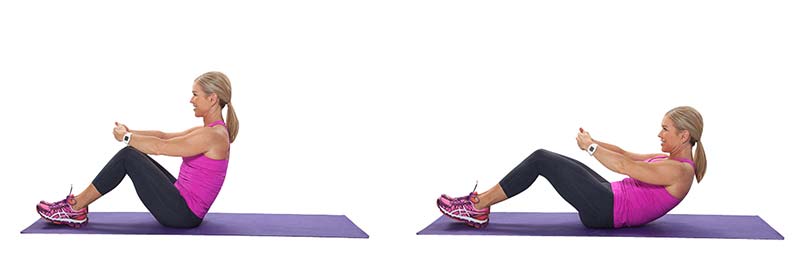
How To: Start seated on the mat, tall and lengthened with knees bent. Inhale to prepare and then exhale as you curve your spine and roll back as far as possible while keeping your feet on the mat. Inhale and return to the starting position. Do 10 reps for warm-up.
100's
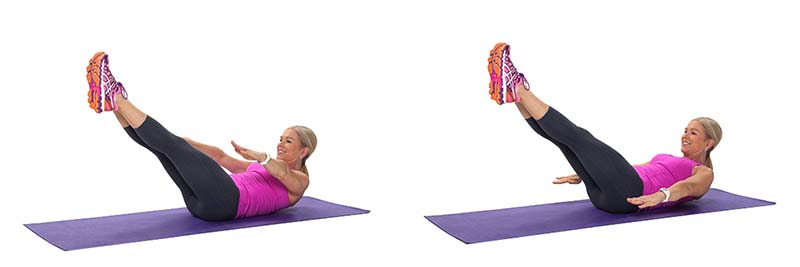
How To: Begin by lying on your back with feet long and extended at an angle. To modify, bend your knees into tabletop. Engage your abdominals as you lift your shoulder blades off the floor. Extend your arms towards your heels. Pump your arms up and down with a small range of motion. Inhale for five pumps and exhale for five pumps. That equals one cycle. Focus on engaging the transverse abdominis. Repeat the cycle nine more times for a total of 100 pumps.
Full Body Roll-Ups

How To: Lie flat on your back with your arms extended overhead. Inhale arms to the sky, exhale and slowly roll up into a “C” curve while reaching for your toes. (Think about threading your belly button to your spine as you activate your transverse abdominis.) Inhale and start to slowly go back in a C curve. Exhale as you uncurl your body one vertebra at a time back into the mat. The key is to keep your feet on the ground. Use your abs and back to gracefully articulate down to the mat and avoid using your hip flexors and glutes. Do five to eight reps.
Sprinter Sit-Ups
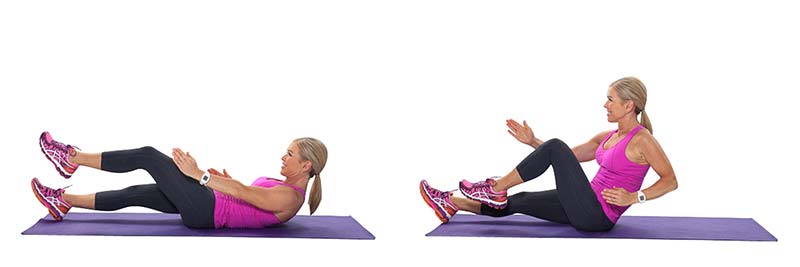
How To: Lie on your back with your arms at your sides and legs extended. Explosively sit up as far as you can while driving your right arm forward and your left knee to your chest. The motion looks somewhat like you’re sprinting. Repeat 10 times on this side and then switch to the other side.
V-Ups
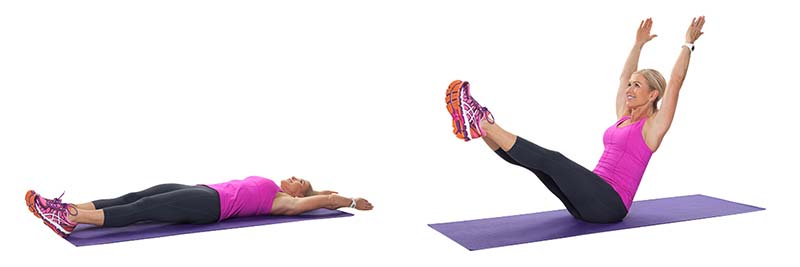
How To: Lie on your back and extend your arms behind your head. Keep your feet together and toes pointed. Keep your legs straight and lift them up as you simultaneously raise your upper body off the floor. Keep your core tight as you reach for your toes with your hands. Slowly lower yourself back down to the starting position. Do 10 reps.
Russian Twists
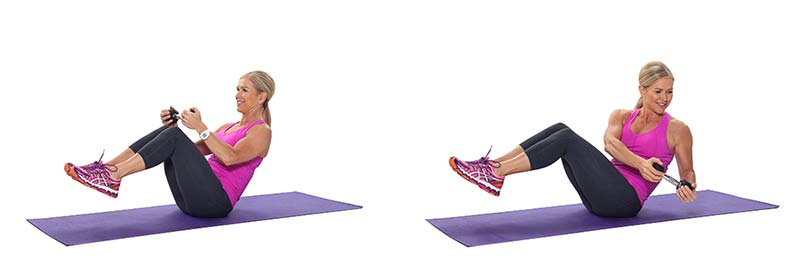
How To: Start seated with knees bent and feet flat on the floor, holding one weight or a medicine ball with both hands in front of chest. Keeping the spine long and the abs tight, lean back slightly and lift the feet a few inches off the floor. (To modify, keep the feet on the floor.) Slowly twist the torso to the left and bring the weight beside the left hip. Return to center and then slowly twist to the right and bring the weight beside the right hip. That’s one rotation. Do 10 full rotations.
Oblique Crunches
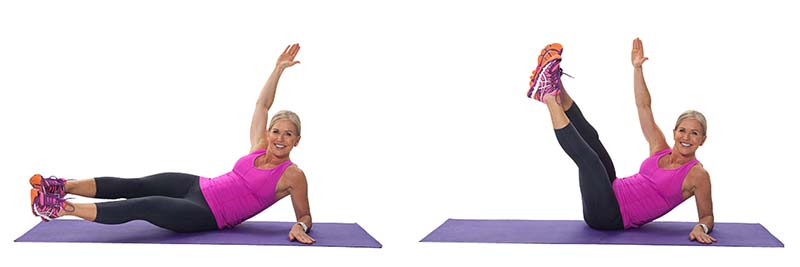
How To: Start with your left hip and left forearm touching the ground (think of it as if you’re lying on one back packet of your blue jeans). With straight legs and an extended right arm, contract your core as you reach your toes up to your hand. Do 10 times. Repeat on the other side.
Bird Dog Crunch
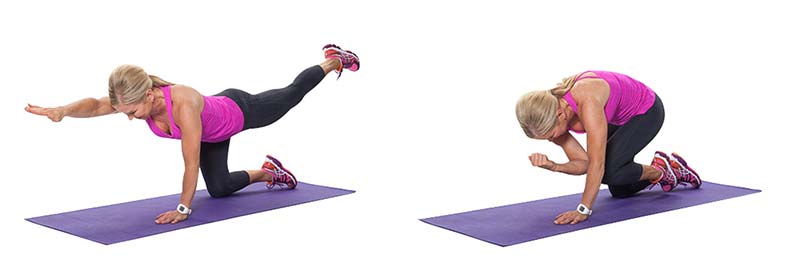
How To: Start on all fours, keeping your spine and neck in a neutral position while looking at the floor. Extend your left leg behind you and reach your right arm forward. Hold for one count. Then, bring your elbow to the knee as you round your back and engage your core. Return to the extended position. Do 10 reps, and then repeat with the right leg and left arm.
Spiderman Plank Abs
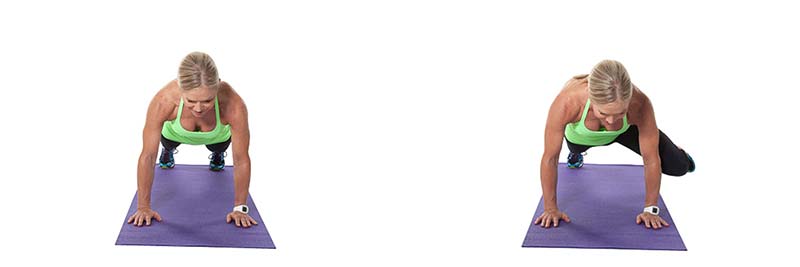
How To: Start in plank position with hands under the shoulders and the abs engaged. Your body should form a straight line from head to hips. Pull the left knee toward the outside of your left elbow and hold for one count. Return to the starting and repeat on right side. Do 20 alternating reps.
Swimmers

How To: Lie on your stomach with the legs and arms extended. Engage your abs so you feel your transverse abdominis contract. With your arms and legs extended and lifted off the floor and nose toward the mat, flutter your arms and legs, moving from the hips and shoulders (not the knees and elbows). Swim for 30 seconds.




 by
by 






 by
by